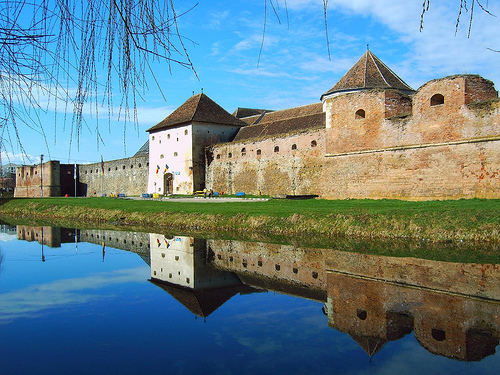

Location: Braşov County Map
Constructed: 1310
Făgărașului Citadel is located in the very center of Făgăraș municipality, in Brașov County, Transylvania, Romania.
The construction of the fortress began in 1310, on the site of an
older earth and wood fortification from the 12th century. The purpose of
building the fortress was eminently strategic, more precisely for the
defense of southeastern Transylvania from the incursions of the Tatars
and the Ottomans.
In 1526, after becoming voivode of
Transylvania, Ștefan Mailat, son of a boyar from the region, took
possession of Făgăraş and the surrounding domains and started the
transformation of the fortress into a real fortified fortress. The
defensive walls were doubled in thickness starting from the inside. New
spaces were arranged in rooms and vaulted halls. In 1541, the Ottomans
led by Mustafa Pasha attacked the fortress. Mailat fell in the race and
was held prisoner in the prison of the Citadel of the Seven Towers
(Edikule) in Constantinople, where he died 10 years later.
In
1599, Mihai the Brave occupied the fortress, gave it to his wife, Mrs.
Stanca, along with the domain, and, becoming prince of Transylvania,
sheltered his family and royal treasury here, a few years later.
In 1617, the last two levels of the southwest tower (donjon), also known
as the Red Tower, which has five levels, were raised.
During the
17th century, with brief interruptions, Făgărașul was a true capital of
the principality of Transylvania, the citadel becoming the residence of
the princes of Transylvania. The Transylvanian Diet met here in 11 rows.
In 1630 the defense moat surrounding the fortress was widened and
connected by a secret canal to the Olt river. A folding bridge was
installed at the entrance. Later, the cellars were converted into
dungeons where rebellious serfs were imprisoned.
In 1657, the
princess-consort Zsuzsanna Lorántffy (wife of Prince Gheorghe Rákóczi
I), mistress of the Făgăraş Citadel, established the first school
(medium level) with Romanian language of instruction, in Făgăraș, which
operated under the patronage of the princess.
After Transylvania
came under Habsburg rule, in 1696, the Făgăraş Fortress was taken over
by the Austrians and became a barracks, starting in 1699, and a military
prison.
In 1721, Făgărașul became the headquarters of the
Romanian Episcopate United with Rome (Greek-Catholic), the bishop's
residence being on the first floor of the south wing of the castle. But
bishop Ioan Giurgiu Patachi preferred to live at Brukenthal Castle from
Sâmbăta de Jos, and Inocentiu Micu-Klein moved his episcopal residence,
through an exchange of properties, from Făgăraș to Blaj in 1737.
Nicolae Iorga visited the fortress in 1903 and found it close to ruin.
Between 1948 and 1960, the fortress served as a prison for opponents
of the communist system in Țara Făgăraşului, political prisoners,
Făgăraşului becoming one of the prisons in the Romanian Gulag system.
In the following years (1965-1977) repair, restoration and
conservation work was done.
Currently, the citadel houses the "Valer Literat" Făgăraș Country Museum, as well as the Municipal Library.